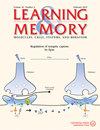The impact of extinction timing on pre-extinction arousal and subsequent return of fear
IF 1.8
4区 医学
Q4 NEUROSCIENCES
引用次数: 0
Abstract
Exposure-based therapy is effective in treating anxiety, but a return of fear in the form of relapse is common. Exposure is based on the extinction of Pavlovian fear conditioning. Both animal and human studies point to increased arousal during immediate compared to delayed extinction (>+24 h), which presumably impairs extinction learning and increases the subsequent return of fear. Impaired extinction learning under arousal might interfere with psychotherapeutic interventions. The aim of the present study was to investigate whether arousal before extinction differs between extinction groups and whether arousal before extinction predicts the return of fear in a later (retention) test. As a highlight, both the time between fear acquisition and extinction (immediate vs. delayed) and the time between extinction and test (early vs. late test) were systematically varied. We performed follow-up analyses on data from 103 young, healthy participants to test the above hypotheses. Subjective arousal ratings and physiological arousal measures of sympathetic and hypothalamic pituitary adrenal axis activation (tonic skin conductance and salivary cortisol) were collected. Increased pre-extinction arousal in the immediate extinction group was only confirmed for subjective arousal. In linear regression analyses, none of the arousal measures predicted a significant return of fear in the different experimental groups. Only when we aggregated across the two test groups, tonic skin conductance at the onset of extinction predicted the return of fear in skin conductance responses. The overall results provide little evidence that pre-extinction arousal affects subsequent extinction learning and memory. In terms of clinical relevance, there is no clear evidence that exposure could be improved by reducing subjective or physiological arousal.灭绝时间对灭绝前唤醒和随后恐惧恢复的影响
暴露疗法能有效治疗焦虑症,但以复发形式出现的恐惧卷土重来也很常见。暴露疗法的基础是巴甫洛夫恐惧条件反射的消退。动物和人体研究都表明,与延迟消退(24 小时以上)相比,立即消退时的唤醒程度更高,这可能会损害消退学习并增加随后的恐惧复发。唤醒状态下的消退学习受损可能会干扰心理治疗干预。本研究的目的是调查不同的消退组在消退前的唤醒程度是否存在差异,以及消退前的唤醒程度是否能预测在之后的(保持)测试中恐惧感的恢复。为了突出研究的重点,我们系统地改变了恐惧获得与消退之间的时间(即时消退与延迟消退)以及消退与测试之间的时间(早期测试与晚期测试)。我们对 103 名年轻健康参与者的数据进行了后续分析,以验证上述假设。我们收集了主观唤醒评分以及交感神经和下丘脑垂体肾上腺轴激活的生理唤醒测量(强直性皮肤电导和唾液皮质醇)。只有在主观唤醒方面证实了立即灭绝组在灭绝前唤醒程度的增加。在线性回归分析中,没有一个唤醒测量指标能预测不同实验组中恐惧的显著恢复。只有当我们将两个试验组的情况汇总时,开始消退时的强直性皮肤电导才能预测皮肤电导反应中恐惧的恢复。总体结果几乎没有证据表明,消退前的唤醒会影响随后的消退学习和记忆。就临床相关性而言,没有明确的证据表明可以通过降低主观或生理唤醒来改善暴露。
本文章由计算机程序翻译,如有差异,请以英文原文为准。
求助全文
约1分钟内获得全文
求助全文
来源期刊

Learning & memory
医学-神经科学
CiteScore
3.60
自引率
5.00%
发文量
45
审稿时长
6-12 weeks
期刊介绍:
The neurobiology of learning and memory is entering a new interdisciplinary era. Advances in neuropsychology have identified regions of brain tissue that are critical for certain types of function. Electrophysiological techniques have revealed behavioral correlates of neuronal activity. Studies of synaptic plasticity suggest that some mechanisms of memory formation may resemble those of neural development. And molecular approaches have identified genes with patterns of expression that influence behavior. It is clear that future progress depends on interdisciplinary investigations. The current literature of learning and memory is large but fragmented. Until now, there has been no single journal devoted to this area of study and no dominant journal that demands attention by serious workers in the area, regardless of specialty. Learning & Memory provides a forum for these investigations in the form of research papers and review articles.
 求助内容:
求助内容: 应助结果提醒方式:
应助结果提醒方式:


